Islamic Courtly Textiles and Trade Goods from the 14th-19th century
Apr 08, 2011 Exhibition
The exhibition and catalogue will show a concise selection of around twenty textiles ranging from Mamluk Egypt and Nasrid Spain to Sultanate and Mughal India, Safavid Iran and Ottoman Turkey, and is a rare opportunity to view such stunning craftsmanship at close hand. Textiles have always played an important role in the social and economic life of the Muslim world, and were a means to display wealth, taste and power.
The costume and interior decoration textiles of the Ottoman, Safavid and Mughal courts during the 16th and 17th century rivaled the Renaissance courts of the same era. Textiles were considered luxury goods of great importance, and diplomatic gifts kept in royal reasuries as well as contemporary paintings provide unique insight into the production and economic significance of the lavish but refined fabrics created in the Mughal, Ottoman and Safavid courts. Textiles were integral to ceremonial and court life. This strictly regulated industry produced silks, velvets and embroideries of superlative quality and design in royal ateliers, often housed within the palace grounds. The best were for the sole use of the ruler and his court, but they were also an important means of trade and diplomacy. No other nationality produced figurative velvets to compete with the Safavid weavers under the control of Shah Abbas I (1587-1629). Robes of honour made of this fabric were given as highly prized diplomatic gifts to the Russian, Ottoman and Mughal courts.
India has been famous for its painted cottons and embroideries since Roman times. Today our knowledge relies on historical trade accounts kept by Europeans who had trading outposts in India. Recent discoveries have identified an important and long standing trade of differently designed Indian cottons for a South-East Asian market. The Muslim rulers of India, both the Mughal emperors and the Deccani Sultans had highly developed textile workshops for their consumption. Textiles are particularly susceptible to decay or damage, and only a small number have survived. Although there have been a number of intelligent and exciting exhibitions and in-depth studies of specific areas of Islamic textile production, a major museum exhibition on this subject as a whole has never been undertaken.
Prices range from £1,500 to £180,000
A catalogue will accompany the exhibition.
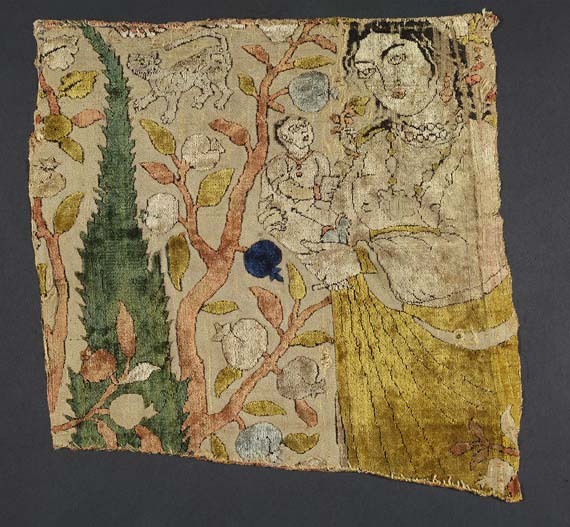
Safavid Iran, early 17th century, Silk velvet, 28 x 27 cm / A Safavid velvet depicting a mother holding her child beside a cyprus and pomegranate tree. The technique of weaving conforms to Safavid production but the woman’s face is not strictly Persian which would suggest a foreign weaving centre, perhaps in India, staffed by Persian weavers or a vigorous export market since this textile and others from this group originally came from Tibet.

A spectacular early 17th century royal chintz floor spread made for the Golconda court in the Deccan which has survived because it was kept in the treasury of the Amber Palace outside Jaipur. In the early 20th century the legendary dealer/collectors Imre Schreiger and Nasli Heeramaneck brought this group of royal chintzes to the United States. Heeramaneck’s private collection of Indian art is now divided between the Los Angles County Museum and the Virginia Museum of Fine Arts.
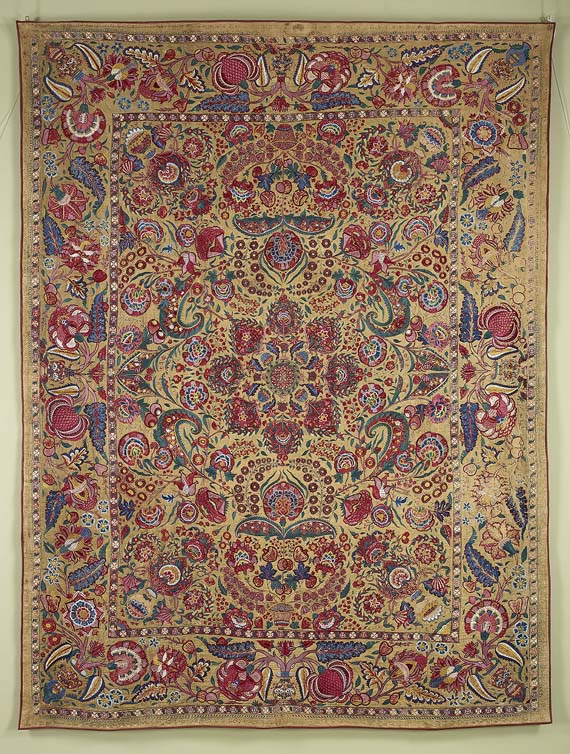
West India, Gujarat, 18th century, Silk embroidery on cotton, 22 x25 cm / An 18th century coverlet from the Deccan with a vigorous floral design embroidered with spectacular colours. A similar example is now in a Portuguese museum confirming our suspicion that these embroideries were made for export to Europe.
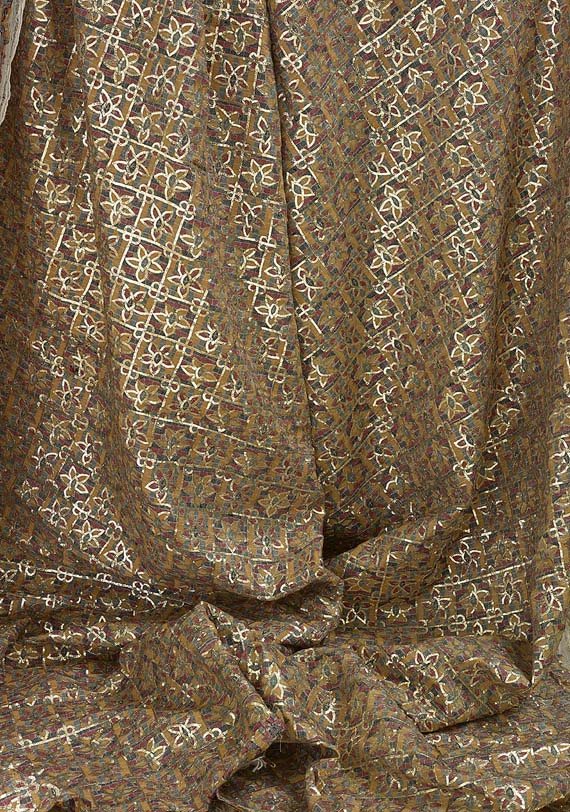
King George V (1865-1936) was passionate about hunting. When he visited India in 1911 for the Delhi Durbar, he went to Nepal to hunt tigers at the invitation of the King of Nepal and his prime minister. Gifts of Bengal jamdani muslin ostentatiously embroidered with gold were given to King George V and are now on loan from HM the Queen to the Victoria & Albert Museum. George V did not keep everything he was given. On show will be similar examples from the estate of his valet, Richard Howlett.
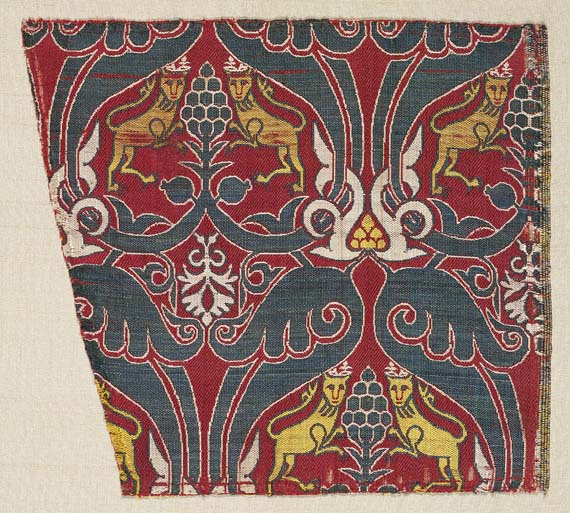
Nasrid Spain, late 15th century, Silk lampas, 22 x 25 cm / A 15th century silk fragment from Spain depicts in vivid colours rampant crowned lions under split palmette leaves. At least five variations of this popular design pattern were woven in Spain in different colour-ways throughout the second half of the 15th century and early 16th century. The Nasrid rulers (1232-1492) of the kingdom of Granada were the last Muslim dynasty in Andalucia and their survival was due to shrewd political compromises and alliances with their Muslim and Christian neighbours. By the 14th century Granada was famed for the high quality of her silk production which continued throughout the 15th and early 16th century when silk weavers continued to produce Nasrid style silks for their new Christian patrons.
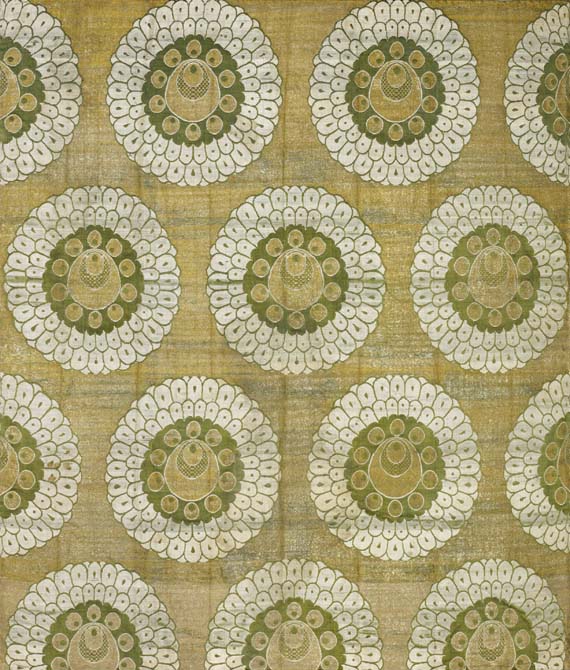
An Ottoman textile from the second half of 16th century. This small but spectacular panel of silk lampas woven with silver-gilt lamella is of utmost elegance. The interior of the cintamani is decorated with a smallscale diaper pattern, adopted from a decorative device used in Italian, particularly Venetian silks in the second half of the 16th century. This device adds visual texture to this grand and yet restrained and utterly satisfying design
Photo: main photo above. Ottoman Turkey, possibly Palace workshop, late 18th-early19th century Silk and metal embroidery on wool 124 x 118 cm / A sumptuous and unusual Ottoman embroidered cover, with European influence. The salmon coloured wool, embroidered with a flamboyant design of large curled feathers surrounding exotic flowers and shell-like motifs, revolving around a central medallion with four radiating flowers. The design combined with an abundant use of flat silver and silver-gilt lamella gives it its exuberant style of decoration, influenced by European late Baroque and Rococo styles.
All photos: Courtesy of Francesca Galloway
Francesca Galloway has been dealing in Indian Miniatures, Islamic and European Textiles for over 30 years. Having worked for Christie’s in Rome for several years, Francesca joined Spinks in 1976 at the height of the Persian art boom. She successfully ran their Islamic department and also transformed Spinks into a major venue for textiles and 20th century costume. Francesca set up her own business in 1992, opening her gallery at 31 Dover Street in 2006.
For further information please contact:
Diana Cawdell / Abi Gold
Cawdell Douglas
T: +44 (0)207 439 2822
F: +44 (0)207 287 5488
E: .(JavaScript must be enabled to view this email address)
Gallery opening times:
Monday to Friday 9.30am to 5.30pm
Francesca Galloway Ltd
31 Dover Street,
London
W1S 4ND
Comments
Add a comment